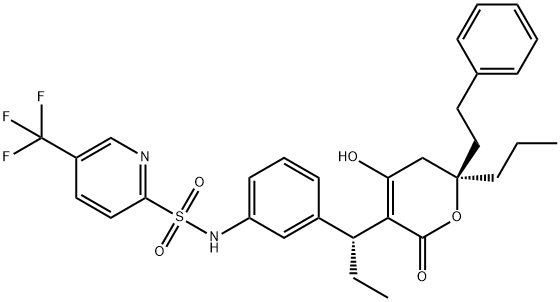174484-41-4
 174484-41-4 結構式
174484-41-4 結構式
基本信息
N-[3-[(1R)-1-[(6R)-2-羥基-4-氧代-6-苯乙基-6-丙基-5H-吡喃-3-基]丙基]苯基]-5-(三氟甲基)吡啶-2-磺酰胺
Tipranavir
PNU-140690
Tipranavir(PNU-140690,Aptivus)
N-[3-[(1R)-1-[(6R)-2-Hydroxy-4-oxo-6-phenethyl-6-propyl-5H-pyran-3-yl]propyl]phenyl]-5-(trifluoromethyl)pyridine-2-sulfonamide
N-[3-[(1R)-1-[(6R)-5,6-Dihydro-4-hydroxy-2-oxo-6-(2-phenylethyl)-6-propyl-2H-pyran-3-yl]propyl]phenyl]-5-(trifluoromethyl)-2-pyridinesulfonamide
2-PyridinesulfonaMide,N-[3-[(1R)-1-[(6R)-5,6-dihydro-4-hydroxy-2-oxo-6-(2-phenylethyl)-6-propyl-2H-pyran-3-yl]propyl]phenyl]-5-(trifluoroMethyl)-
物理化學性質
常見問題列表
IC50: 66-410 nM (HIV-1 isolates)
Tipranavir (PNU-140690) inhibits the enzymatic activity of HIV-1 protease, blocks the dimerization of protease subunits, and exerts potent activity against a wide spectrum of wild-type and multi-PI-resistant HIV-1 variants. When a mixture of 11 multi-PI-resistant (but TPV-sensitive) clinical isolates (HIV 11MIX ), which include HIV B and HIV C , is selected against Tipranavir, HIV 11MIX rapidly (by 10 passages [HIV 11MIX P10 ]) acquires high-level Tipranavir (PNU-140690) resistance and replicates at high concentrations of Tipranavir (PNU-140690). cHIV B I54V and cHIV B I54V/V82T are significantly resistant to Tipranavir (PNU-140690), with IC 50 s of 2.9 and 3.2 μM, respectively, which are 11- and 12-fold increases in comparison to the IC 50 against cHIV B , respectively.
Tipranavir (PNU-140690) is administered orally twice daily and must be given in combination with low-dose ritonavir (RTV) to boost Tipranavir bioavailability. In Tipranavir/r-cotreated mice, the Tipranavir (PNU-140690) abundance in the liver, spleen, and eyes is significantly higher than that in mice treated with Tipranavir alone. Tipranavir (PNU-140690) metabolites accounts for 31 and 38% in the serum and liver in the Tipranavir-alone group. In Tipranavir (PNU-140690) and Tipranavir (TPV/r)-cotreated mice, only 1 and 2% of metabolites are detected in the serum and liver. Sprague-Dawley rats are administered a single dose of [ 14 C]Tipranavir (PNU-140690) with coadministration of RTV. The most abundant metabolite in feces is an oxidation metabolite. In urine, no single metabolite is found to be significantly present.
